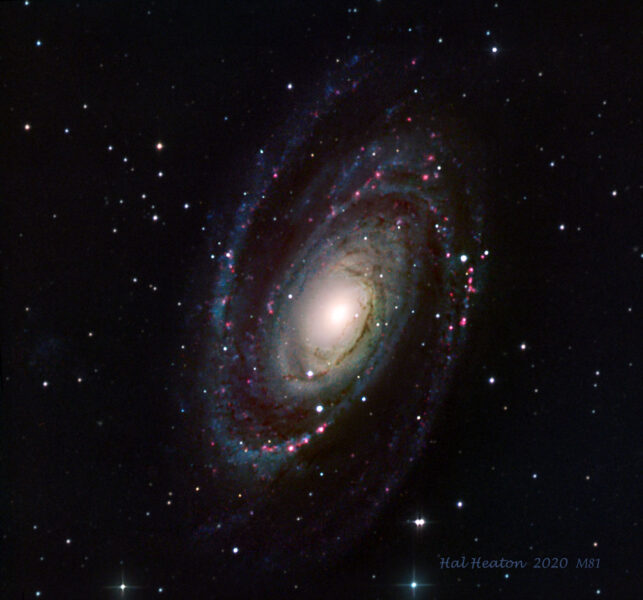Giant flares emitted from the surface of highly magnetized neutron stars could explain some gamma-ray flashes astronomers have caught over the past few decades.
Cosmic explosions are not always what they seem. A blast detected on April 15, 2020, demonstrates that not all short gamma-ray bursts — the most powerful detonations in the universe — come from distant neutron star collisions, as astronomers had thought. Some are actually much less energetic giant flares on highly magnetized neutron stars, known as magnetars, much closer to Earth.

NASA’s Goddard Space Flight Center/Chris Smith / USRA / GESTAR
Which is not to say they aren’t calamitous: the recently observed burst, GRB 200415A, released 10 quadrillion times more energy than the Chicxulub impact that killed the dinosaurs 66 million years ago.
“The possibility that a subset of short gamma-ray bursts is associated with magnetar giant flares has been suggested long ago, and this detection is key in proving it right,” comments Roberto Turolla (University of Padua, Italy), who was not involved in the research.
Upending Theory
Astronomers thought they had gamma-ray bursts all figured out. Those lasting longer than two seconds come from core-collapse supernovae of massive, rapidly rotating stars, while shorter ones come from colliding neutron stars. Both types are extremely rare, and most gamma-ray bursts are seen at distances of hundreds of millions or even billions of light-years.
In contrast, GRB 200415A originated in NGC 253, the Sculptor Galaxy, a starburst in our cosmic backyard at just 11.4 million light-years away. This burst behaved very much like giant flares on magnetars in our own Milky Way. “This was a masquerading magnetar,” says Kevin Hurley (University of California, Berkeley). “We unmasked it.”
The magnetar’s giant flare released about a million times less power than a short gamma-ray burst resulting from a neutron star collision. But seen from relatively nearby, both may look more or less the same, just like a nearby firecracker may sound as dramatic as a remote explosion.
The new results were presented at the virtual 237th meeting of the American Astronomical Society, and in three papers, two in Nature and one in Nature Astronomy.
Punch-packing Crust Crackers
Magnetars have magnetic fields 100 trillion times stronger than Earth’s. Astronomers have discovered about 30 of these highly magnetized and relatively slow-spinning neutron stars in our Milky Way so far. Some produce intermittent bursts of low-energy gamma-rays – these are known as soft gamma repeaters. And between 1979 and 2004, two of those (plus one in the Large Magellanic Cloud) released a giant flare: an extremely brief burst of X-rays and gamma-rays, temporarily outshining the whole sky at these high energies.
The three nearby flares completely saturated satellite-mounted gamma-ray detectors. “They pack quite a punch,” says Victoria Kaspi (McGill University). The brief flares (on the order of 0.1 second) are emitted when twisted magnetic field lines crack the high-density crust of the neutron star. Imagine a magnitude-28 quake on the Richter scale, says Hurley. “In California, we would certainly call that the Big One.” Through the fractured crust, a huge blob of charged particles is ejected into space at some 99% of the speed of light.
Although the majority of short gamma-ray bursts come from distant neutron star mergers, astrophysicists have always realized that less energetic, nearby magnetar flares could create some of them, explains Hurley. By comparing a burst’s arrival time at various gamma-ray detectors in space (three in Earth orbit, one at the L1 libration point between Earth and the Sun, and one on the Mars Odyssey orbiter), scientists triangulated the source. In three cases, a short gamma-ray burst appeared to originate in a nearby galaxy (M81, M31, and M83). Statistical arguments further suggest that a few percent of all short bursts are actually masquerading magnetars.

Hal Heaton / S&T Online Photo Gallery
GRB 200415A is now one of the most convincing cases, but it’s not a complete shoo-in. “Maybe it’s not the smoking gun yet,” comments Kaspi, who was not involved in the research, “but at least it’s a clear fingerprint on the crime scene.”
Astronomers would have loved to also see the tail end of the event, like they did in the case of the three closer magnetars, which in those cases revealed a slowly fading pulsation that betrayed the object’s relatively slow spin rate. However, at extragalactic distances, this telltale signal is simply too faint to see.
Nevertheless, says co-investigator Ersin Göğüş (Sabanci University, Turkey), the team collected detail never seen before from these events. That’s because this flare was far enough, and therefore faint enough, that it didn’t saturate the Gamma-ray Burst Monitor onboard NASA’s Fermi Gamma-ray Space Telescope or the Burst Alert Telescope of the Neil Gehrels Swift spacecraft.
In particular, Göğüş says, Fermi’s detection of a handful of high-energy gamma-ray photons between 19 seconds and 4.7 minutes after the event was “a big surprise.”
Fermi-LAT team member Nicola Omodei (Stanford University) says that that signal may have been produced when the ejected plasma slammed into a bow shock, created as the magnetar moves through interstellar space. Since Fermi launched in 2008, it wasn’t around to see if similar high-energy components were associated with the three nearby magnetar flares. “The giga-electronvolt emission will certainly be in the spotlight for future giant flare detections, both in the Milky Way and in nearby galaxies,” says Göğüş.
Remaining Riddles
“If a few percent of short gamma-ray bursts are actually giant flares from magnetars — which are extremely rare events — then the number of magnetars in the universe must be huge,” says Kenzie Nimmo (University of Amsterdam). Maybe, she suggests, there’s more than one way to create a magnetar.
But this would of course also depend on the frequency of giant flares, which is unknown. “Gauging the magnetar population from giant flares is not good,” warns Turolla. Kaspi notes that there are many other questions remaining. “Do all magnetars have giant flares? Can magnetars have multiple ones? We just don’t know.”
One final mystery is the relationship between magnetar giant flares and fast radio bursts (FRBs). On April 27, 2020, a Milky Way magnetar known as SGR 1935+2154 produced one of these millisecond eruptions of radio waves that occur at prodigious rates all over the sky.
“It’s plausible that a magnetar giant flare at extragalactic distance could also produce a radio flash similar in brightness to a fast radio burst,” says FRB expert Jason Hessels (University of Amsterdam). “It would have been nice if a radio telescope was looking in the direction of GRB 200415A, although the radio flash is likely beamed and might still have missed the Earth.”
Göğüş agrees, “[Magnetars] do have the infrastructure to generate energetic X-ray and gamma-ray bursts, as well as fast radio bursts.”
But according to Kaspi, the fast radio bursts are not necessarily related to “crust quakes” on the neutron star’s surface – they’re more likely produced by something in the object’s magnetosphere.
“It is possible that the mechanisms behind giant flares and fast radio bursts are completely different,” Nimmo agrees.
With so much uncertainty, scientists can only hope for more explosive events to study with more sensitive instruments. Team member Eric Burns (Louisiana State University) looks forward to the StarBurst gamma-ray mission, which was recently selected for further concept development within NASA’s new Astrophysics Pioneers program for small-scale missions. StarBurst could detect a few magnetar giant flares per year, Burns says: “The study of GRB200415A is really laying the groundwork for future research.”
 2
2









Comments
John
January 15, 2021 at 4:28 pm
"...Which is not to say they aren’t calamitous: the recently observed burst, GRB 200415A, released 10 quadrillion times more energy than the Chicxulub impact that killed the dinosaurs 66 million years ago...."
A bit of a silly comparison, don't you think? What does "10 quadrillion times more energy" even mean??? That's waaaay beyond the Hrair limit!
You must be logged in to post a comment.
Monica Young
February 25, 2021 at 12:47 pm
Much of astronomy lies well beyond the Hrair limit 😀
You must be logged in to post a comment.
You must be logged in to post a comment.